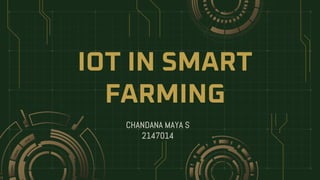IOT in Smart Farming
•Télécharger en tant que PPTX, PDF•
0 j'aime•264 vues
Technologies available in the field of agriculture making an easy task for the farmers in increasing the productivity and other techniques of irrigation resulting in better use of water resources available.
Signaler
Partager
Signaler
Partager

Contenu connexe
Tendances
Tendances (20)
IoT Based Agriculture Monitoring and Smart Irrigation System using Raspberry Pi

IoT Based Agriculture Monitoring and Smart Irrigation System using Raspberry Pi
Smart agriculture using iot (fully smart) By using arduino

Smart agriculture using iot (fully smart) By using arduino
Similaire à IOT in Smart Farming
Similaire à IOT in Smart Farming (20)
A review of the literature on IOT-based smart agriculture monitoring and cont...

A review of the literature on IOT-based smart agriculture monitoring and cont...
IRJET - IoT based Mobile App for E-Farming using Decision Support System Irri...

IRJET - IoT based Mobile App for E-Farming using Decision Support System Irri...
IoT-Based Sustainable Farming: A Momentous Innovation in the Agriculture Sect...

IoT-Based Sustainable Farming: A Momentous Innovation in the Agriculture Sect...
Revolutionizing Agriculture: The Role of Industrial Wireless Sensors

Revolutionizing Agriculture: The Role of Industrial Wireless Sensors
Dernier
Dernier (20)
[2024]Digital Global Overview Report 2024 Meltwater.pdf![[2024]Digital Global Overview Report 2024 Meltwater.pdf](data:image/gif;base64,R0lGODlhAQABAIAAAAAAAP///yH5BAEAAAAALAAAAAABAAEAAAIBRAA7)
![[2024]Digital Global Overview Report 2024 Meltwater.pdf](data:image/gif;base64,R0lGODlhAQABAIAAAAAAAP///yH5BAEAAAAALAAAAAABAAEAAAIBRAA7)
[2024]Digital Global Overview Report 2024 Meltwater.pdf
The Role of Taxonomy and Ontology in Semantic Layers - Heather Hedden.pdf

The Role of Taxonomy and Ontology in Semantic Layers - Heather Hedden.pdf
08448380779 Call Girls In Civil Lines Women Seeking Men

08448380779 Call Girls In Civil Lines Women Seeking Men
Tech Trends Report 2024 Future Today Institute.pdf

Tech Trends Report 2024 Future Today Institute.pdf
Understanding Discord NSFW Servers A Guide for Responsible Users.pdf

Understanding Discord NSFW Servers A Guide for Responsible Users.pdf
What Are The Drone Anti-jamming Systems Technology?

What Are The Drone Anti-jamming Systems Technology?
Strategize a Smooth Tenant-to-tenant Migration and Copilot Takeoff

Strategize a Smooth Tenant-to-tenant Migration and Copilot Takeoff
08448380779 Call Girls In Diplomatic Enclave Women Seeking Men

08448380779 Call Girls In Diplomatic Enclave Women Seeking Men
08448380779 Call Girls In Greater Kailash - I Women Seeking Men

08448380779 Call Girls In Greater Kailash - I Women Seeking Men
Bajaj Allianz Life Insurance Company - Insurer Innovation Award 2024

Bajaj Allianz Life Insurance Company - Insurer Innovation Award 2024
Mastering MySQL Database Architecture: Deep Dive into MySQL Shell and MySQL R...

Mastering MySQL Database Architecture: Deep Dive into MySQL Shell and MySQL R...
How to Troubleshoot Apps for the Modern Connected Worker

How to Troubleshoot Apps for the Modern Connected Worker
Strategies for Landing an Oracle DBA Job as a Fresher

Strategies for Landing an Oracle DBA Job as a Fresher
IOT in Smart Farming
- 2. AGENDA ● What is IOT? ● Structure of IOT ● IOT in Agriculture ● Types of smart sensors in agriculture for farming ● Advantages and Disadvantages ● Conclusion
- 3. What is IOT? ● The Internet of Things (IoT) describes the network of physical objects. ● Things that are embedded with sensors, software, and other technologies for the purpose of connecting and exchanging data with other devices and systems over the internet. ● This system has the ability to transfer data over a network without requiring human-to-human or human-to-computer interaction.
- 6. IOT in Agriculture India ranks second in the world in agriculture. 64% of the cultivated land(farm output) is dependent on monsoons. Irrigation accounts for 55-75% of water usage in India, but 60% of the irrigated water is wasted. Wastage of irrigated water can be prevented by using sensors.
- 7. Crop water management Pest management and control works Precision agriculture Food production and safety etc., IOT in Agriculture
- 11. PEST MANAGEMENT AND CONTROL WORKS
- 14. Types of smart sensors in agriculture for smart farming Electrochemical Sensor Mechanical Soil Sensor Dielectric Soil Moisture Sensor
- 15. Location Sensor Electronic Sensor Airflow Sensor
- 16. Advantages and Disadvantages Advantages More data means better decisions Ability to track and monitor things Lighten the workload with automation Increases efficiency by saving money and resources Better quality of life Disadvantages Security and Privacy Increased unemployment Too Much Dependency on Technology Lose life control
- 17. Conclusion We can predict soil moisture level and motion of predators. Irrigation system can be monitored. Damage caused by predators can be reduced. Increased productivity. Water conservation. Profit to farmers.